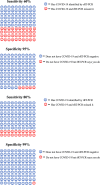Diagnosing COVID-19 in the Emergency Department: A Scoping Review of Clinical Examinations, Laboratory Tests, Imaging Accuracy, and Biases
- PMID: 32542934
- PMCID: PMC7323136
- DOI: 10.1111/acem.14048
Diagnosing COVID-19 in the Emergency Department: A Scoping Review of Clinical Examinations, Laboratory Tests, Imaging Accuracy, and Biases
Abstract
Objective: Severe acute respiratory syndrome coronavirus 2 (SARS-CoV-2) emerged as a global pandemic in early 2020 with rapidly evolving approaches to diagnosing the clinical illness called coronavirus disease (COVID-19). The primary objective of this scoping review is to synthesize current research of the diagnostic accuracy of history, physical examination, routine laboratory tests, real-time reverse transcription-polymerase chain reaction (rRT-PCR), immunology tests, and computed tomography (CT) for the emergency department (ED) diagnosis of COVID-19. Secondary objectives included a synopsis of diagnostic biases likely with current COVID-19 research as well as corresponding implications of false-negative and false-positive results for clinicians and investigators.
Methods: A Preferred Reporting Items for Systematic Reviews and Meta-Analyses-Scoping Review (PRISMA-ScR)-adherent synthesis of COVID-19 diagnostic accuracy through May 5, 2020, was conducted. The search strategy was designed by a medical librarian and included studies indexed by PubMed and Embase since January 2020.
Results: A total of 1,907 citations were screened for relevance. Patients without COVID-19 are rarely reported, so specificity and likelihood ratios were generally unavailable. Fever is the most common finding, while hyposmia and hypogeusia appear useful to rule in COVID-19. Cough is not consistently present. Lymphopenia is the mostly commonly reported laboratory abnormality and occurs in over 50% of COVID-19 patients. rRT-PCR is currently considered the COVID-19 criterion standard for most diagnostic studies, but a single test sensitivity ranges from 60% to 78%. Multiple reasons for false-negatives rRT-PCR exist, including sample site tested and disease stage during which sample was obtained. CT may increase COVID-19 sensitivity in conjunction with rRT-PCR, but guidelines for imaging patients most likely to benefit are emerging. IgM and IgG serology levels are undetectable in the first week of COVID-19, but sensitivity (range = 82% to 100%) and specificity (range = 87% to 100%) are promising. Whether detectable COVID-19 antibodies correspond to immunity remains unanswered. Current studies do not adhere to accepted diagnostic accuracy reporting standards and likely report significantly biased results if the same tests were to be applied to general ED populations with suspected COVID-19.
Conclusions: With the exception of fever and disorders of smell/taste, history and physical examination findings are unhelpful to distinguish COVID-19 from other infectious conditions that mimic SARS-CoV-2 like influenza. Routine laboratory tests are also nondiagnostic, although lymphopenia is a common finding and other abnormalities may predict severe disease. Although rRT-PCR is the current criterion standard, more inclusive consensus-based criteria will likely emerge because of the high false-negative rate of PCR tests. The role of serology and CT in ED assessments remains undefined.
© 2020 by the Society for Academic Emergency Medicine.
Figures




References
-
- Lei P, Fan B, Wang P Differential diagnosis for coronavirus disease (COVID‐ 19): beyond radiologic features. AJR Am J Roentgenol 2020;215:W19. - PubMed
-
- U.S. Food and Drug Administration . Emergency Use Authorization (EUA) information, and list of all current EUAs Food and Drug Administration. 2020. Available at: https://www.fda.gov/emergency‐preparedness‐and‐response/mcm‐legal‐regula.... Accessed Jun 3, 2020.
-
- Lippi G, Plebani M The critical role of laboratory medicine during coronavirus disease 2019 (COVID‐19) and other viral outbreaks. Clin Chem Lab Med 2020;58:1063–9. - PubMed
-
- Tricco AC, Lillie E, Zarin W, et al. PRISMA extension for scoping reviews (PRISMA‐ScR): checklist and explanation. Ann Intern Med 2018;169:476–3. - PubMed
Publication types
MeSH terms
Grants and funding
LinkOut - more resources
Full Text Sources
Medical
Miscellaneous

